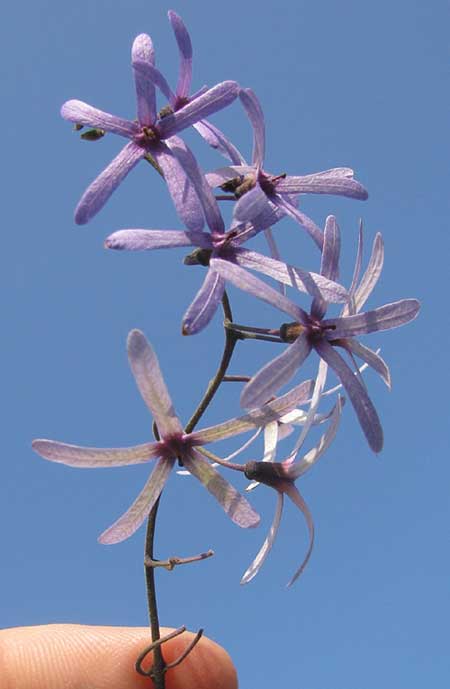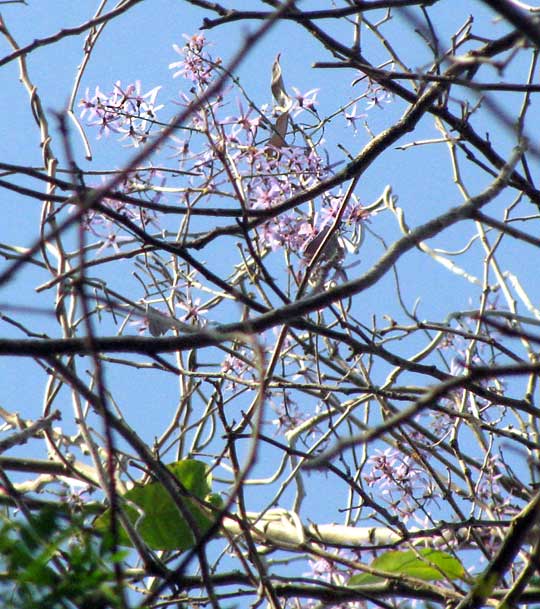Excerpts from Jim Conrad's
Naturalist Newsletter
from the April 11 2010 Newsletter issued from Hacienda Chichen Resort beside Chichén Itzá Ruins, central Yucatán, MÉXICO
A LITTLE CLOUD OF PURPLE
The other day along a trail deep in the woods the shadowy, gloomy browns before me were abruptly broken by the feather-sized bouquet of purple flowers shown below:

I knew not to look around for the bouquet's source, for this was from a high-climbing, woody vine. I looked straight up -- and still didn't see anything. Not until I lay on my back and with binoculars scanned the canopy directly above, peering through various layers of tree limbs, did I finally make out the source, maybe 30 feet (10 m) up, a wispy little cloud of purple with the blue sky beyond, as shown below:

It was the Queens Wreath, PETREA VOLUBILIS, native to tropical America, including here, but most frequently encountered in tropical gardens. In gardens, if it's trained like a grapevine to form a leafy roof for an outside patio, abundant, foot-long, long-enduring, purplish racemes dangle from the ceiling of dark-green leaves. It's a beautiful effect, and accounts for why the species is planted in the tropics worldwide. Back in Querétaro we encountered Queens Wreath in a garden situation, so you can enjoy a hint of the effect at the picture in the next section.
In that picture, notice that in each "flower's" center there's an irregularly shaped item. If I'd had a camera capable of close-ups in Querétaro I'd been able to show that the item at the "flower's" center was -- a flower. In fact, the five-armed items giving the impression of being flowers are actually calyxes with five very long, purple sepals. Usually calyxes and sepals are green and obscure, but not here. A close-up of the actual tiny flower at the calyx's center looks a lot like a verbena flower, which makes sense because Queens Wreath belongs to the Verbena Family, the Verbenaceae.
The little bouquet that had fallen onto the forest floor before me was an older sprig, for the flowers already had fallen off, leaving only the developing ovary surrounded by its colorful calyx tube. You can see how the ovary's old, shriveling stigma and style project from the calyx tube's mouth below:

from the March 17, 2007 Newsletter issued from Sierra Gorda Biosphere Reserve, QUERÉTARO, MÉXICO
QUEEN'S WREATH FLOWERING
Here and there you see a woody vine climbing into trees producing long, slender clusters of pretty, purple flowers. It's the Queen's Wreath, PETREA VOLUBILIS, of the Verbena Family. Those are its flowers below:

This is a native tropical-American vine but it's so pretty that it's grown worldwide. Last year at San Juan in the Yucatán the large trellis over the patio next to the hacienda house supported a large Queen's Wreath that grew like a grapevine. I'd like to sit in its shade right now sipping tea and admiring its foot- long, purple clusters of star-shaped blossoms dangling into the dimness below, charming the whole sitting space. This fine plant can twine up to 40 feet if it's kept watered and has plenty of sun.
The vine is so admired by tropical gardeners that it's been horticulturalized into a number of showy forms. One curiosity about the blossoms is that the flowers' slender "petals" aren't petals at all, but rather colored sepals -- calyx lobes -- that serve the function of petals, which is to attract pollinators with their color. In my photograph you can see inconspicuous corollas in the blossoms' centers.
Corollas typically last only for one or two days, but the petal-like ("petaloid") sepals persist for a good while, often gradually fading to tan as they mature. In my picture you can see how the tiny corollas in the blossoms' center at the bottom of the inflorescence haven't yet opened, just two or three at the inflorescence's center have expanded, and then in the older blossoms at the flower cluster's top the old corollas are shriveled and brown, though the petaloid sepals show little age at all.